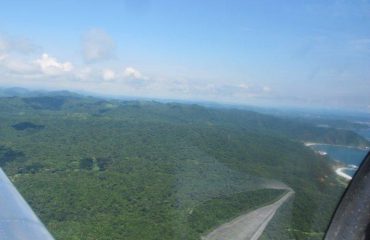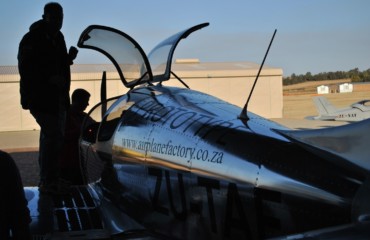What Makes This Sling 4 Different?
Apart from the standard features our production Sling 4 will have, this Sling has been adapted in the following ways for the trip:
- Fuel tanks – increased from 150 liters to 450 liters (giving 24 hours endurance)
- Improved instrumentation – 2 x MGL Voyagers, TCAS, high quality gyros, Navcom radio
- Satellite tracker – care of Dennis Jankelow and Associates and Indigosat
The Sling 4
The Sling 4 concept emerged from the performance of the standard Airplane Factory Sling during Mike and James’ 2009 circumnavigation. Conceived as a 600kg MAUW “light sport” aircraft, it was soon clear that, even with a normally aspirated 100hp motor, the standard Sling was able to climb and perform well right up to at 970kg. The first consequence is that The Airplane Factory Team performed all the required tests and approved the standard aircraft at 700kg MAUW. We also simultaneously commenced work on development of a light 4 seater version of the same aircraft.
The chief differences between the Sling and the Sling 4 are the wing size, the engine and the centre fuselage arrangements. Where the standard Sling customarily uses a 100hp Rotax 912 ULS engine, the Sling 4 will be fitted with the 115hp turbocharged Rotax 914 UL engine. Although a 15hp difference doesn’t sound like the world, the turbocharged engine gives full power at up to 15 000 feet, at which altitude the 100hp would only be delivering approximately 55hp. So on a hot day in Johannesburg the swing in power between the 912 ULS and 914 UL engine is in the vicinity of 36%, not just 15%.
Secondly, the Sling 4 is fitted with the extremely robust and high quality Warp Drive constant speed propeller system. The main consequence of this is that right from the beginning of the take-off roll the engine can be set to rev at a level that provides optimum power. In addition the aircraft can be set to cruise efficiently with minimum fuel burn.
Thirdly, the wing area of the Sling 4 has been increased by approximately 1 square meter by increasing the wing length by 400mm at the root of each wing. No other changes are made to the wing, so the proven flap and aileron systems are retained and of course the forgiving aerofoil is unchanged. While the rear fuselage has been slightly raised and flattened, this will not affect the aircraft aerodynamically (though it slightly improves the structural strength).
Finally, the centre fuselage has been lengthened by 450mm to allow for the rear seats and the canopy has been lengthened to accommodate the seats. The canopy frame is manufactured from carbon fibre and uses a gullwing door arrangement. One benefit of the new canopy arrangement is that it provides significant additional rear fuselage to centre fuselage structural support. This is something that The Airplane Factory had to work very hard on getting in the standard Sling, particularly under negative g loadings.
It is expected that the Sling 4 will perform materially the same as the standard Sling when at MAUW, either 850kg or 870kg. This means that the aircraft will cruise at 112 knots, have a range of nearly 1 000 nm (1 800km), burn approximately 20 lph of mogas or avgas and have a take-off roll at MAUW of approximately 250m. The Sling 4 will have a useful load of not less than 400kg. It accordingly fits into the class of a light 4 seater. If it proves to fly according to plan it will have all the benefits associated with the standard Sling with the added elegance of the longer fuselage and wings!”
Our 2-Seater Sling
The last time we flew around the word, it was with our Sling 2-seater.
The Sling was designed with the aim of creating the most practical and desirable light sport aircraft available.
No single aircraft can fulfill the special needs of every pilot. Nevertheless, The Airplane Factory believes that the Sling enjoys a set of qualities that will fulfill the needs, at the highest level, of many pilots and flight training schools.



